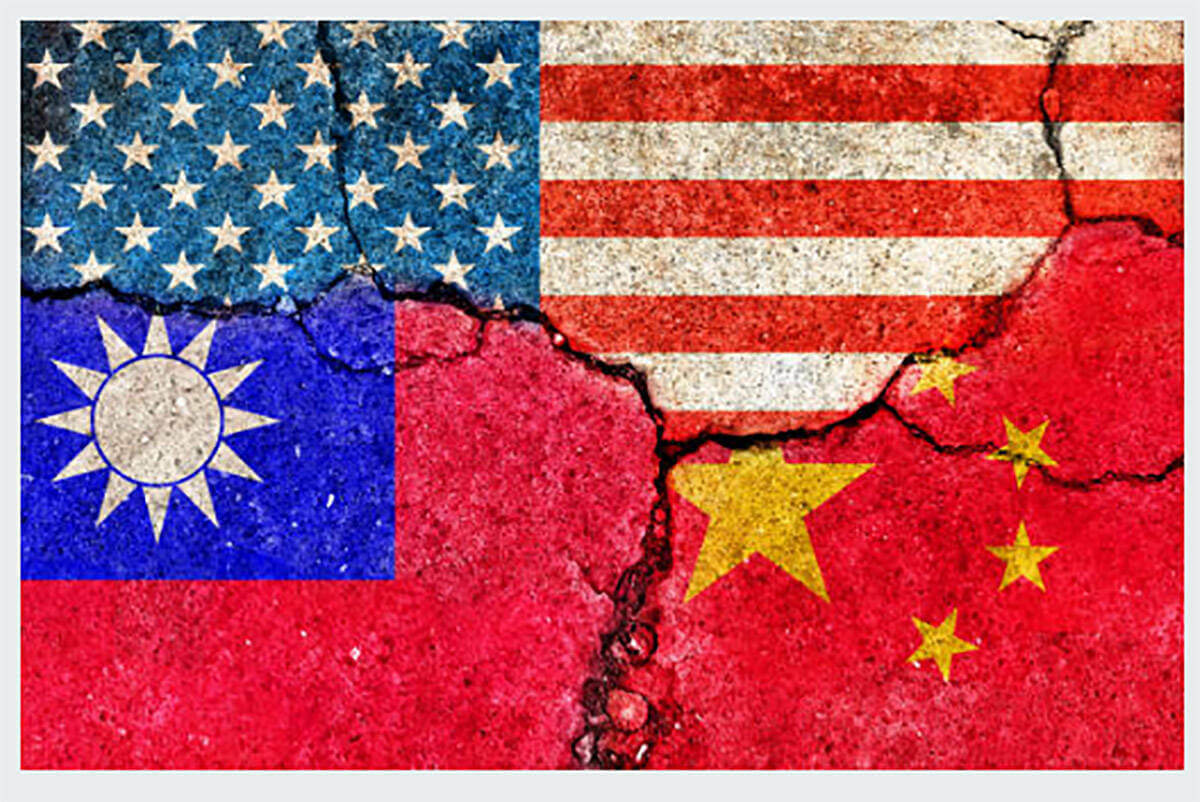Notre Dame experts consider the recent attention toward Taiwan and its impact on U.S.-China relations

In recent weeks, Taiwan has become a hot topic among world leaders, especially within Washington. Taiwan’s president, Tsai Ing-wen, visited California last week to meet with U.S. House Speaker Kevin McCarthy, which prompted China to send warships and warplanes to surround the island and simulate bombing raids and military drills. This week’s threats from China to close down the airspace around Taiwan for three days leading up to the May G7 summit in Japan caused further strains and consternation. Many experts see these aggressive moves as foreshadowing a possible forced annexation of Taiwan by China, which considers the island part of its territory.
These Notre Dame experts consider this attention turned toward Taiwan and what it means for U.S.-China relations from legal, strategic, militaristic, tactical and political standpoints.
No international law has been broken by simulated actions

Mary Ellen O’Connell, the Robert and Marion Short Professor of Law and research professor of international dispute resolution, says simulating military attacks as China is doing in the context of Taiwan is no straightforward violation of international law.
“They do not compare with Russia’s invasion of Ukraine,” she said. “The U.N. Charter prohibits both threats to the peace and breaches of the peace. China’s simulations are classifiable as ‘threats to the peace’ and those, unlike invasion and other actual uses of force, may not violate the international law protecting Taiwan. The charter’s prohibition on the use of actual force is a codified version of ancient moral and legal principles. It does not change and cannot be undermined regardless of persistent state violations. It reaches beyond members of the U.N.”
O’Connell says “threats” are less concrete and less subject to a peremptory prohibition.
“States constantly undermine the prohibition on threats,” she said. “Recall Donald Trump’s threats of ‘fire and fury’ against North Korea in August 2017. Many states also consider U.S. military exercises to be threats. It is hard to say the ban on threats is binding today. And then there is the problem that Taiwan is not a member of the U.N. To enjoy protection from the use of force, Taiwan needs to rely on the ancient legal prohibition beyond the charter.
“All of this means that the U.S. has no right to use military force in a case of simulated action,” she explained. “The best option is to bolster the U.N. Charter’s other mandate on China, the obligation to settle disputes peacefully. Leading by example with strict compliance with ancient and charter-based law is the way forward.”
The US should prepare for possible blockades on Taiwan

Victoria Tin-bor Hui, associate professor of political science, holds expertise in east Asian security, U.S.-China relations, Chinese history and Hong Kong. She recalled when the U.S. simultaneously sent senior officials and members of Congress to both Taiwan and China over a year ago, indicating that the U.S. was edging away from strategic ambiguity and moving closer to strategic clarity. Since then, of course, former Speaker Nancy Pelosi also visited Taipei.
“President Biden has repeatedly stated that the U.S. would come to Taiwan’s military assistance if Taiwan is under attack,” Hui said. “And each time, the White House spokesperson would reiterate the U.S.’s adherence to the ‘One China’ policy. Tsai’s recent high-level meetings and trips demonstrate the U.S.’s new policy of unspoken/de facto strategic clarity under the de jure ‘one China’ pledge.”
This move, Hui said, is intended to deter Chinese President Xi Jinping from invading Taiwan without the need to actually use the military. “Beijing has reacted as if strategic clarity had become the official policy,” Hui explained. “It has demonstrated that it can impose a blockade on Taiwan. If conflicts break out, the most likely scenario is a blockade/siege, rather than direct military confrontations and an amphibious landing (to be saved for when Taiwan is subdued).
“The U.S. should be making plans on how to supply and support Taiwan in case of a prolonged blockade to force Taiwan into submission.”
‘Restless, but not reckless, behavior’

Lionel Jensen, an associate professor of East Asian languages and cultures and concurrent associate professor of history, said that while there is cause for concern, China’s actions amount to “restless, but not reckless, behavior.”
An expert on Chinese nationalism, Jensen said what is needed now is a proper contextualization of China’s reaction.
“It was termed a ‘measured hardline’ by official China media. This is not ominous but routine,” he said. “These exercises are similar — although not as extensive — as those conducted in early August in response to former Speaker Nancy Pelosi’s visit to Taiwan. Then, Taiwan’s Air Defense Identification Zone, the ‘mediating line,’ was crossed dozens of times and two missiles were shot over Taiwan into the Sea of Japan.”
These recent exercises also provided an opportunity for China to show off its improved aircraft carriers, Jensen noted, which could potentially be used to escalate tensions in the South China Sea.
“Of greater concern is the extent to which the aircraft carrier will be used in the South China Sea dispute that’s been ongoing since 2015,” he said, “and whether China will now begin to move in greater force with its weaponry into the different islands they’ve occupied there.”
Jensen said the most dangerous aspect of the simulations in Taiwan is the prospect of an accident: a misfired missile or a collision between aircraft or ships.
“It’s important to note that every time China conducts such exercises over and around Taiwan, the latter scrambles its planes in defense against PRC (People’s Republic of China) fighter jets entering the Air Defense Zone — more than 50 times during the most recent Operation Joint Sword and almost 70 sorties last August,” he said.
“In the end, it is essential that these activities be placed in the context of regular flights into Taiwan’s airspace that are conducted without the public relations pronouncements — veiled threats — from the PRC Foreign Ministry and have been conducted periodically since the 1990s. China’s most recent actions are calculated, and the ‘measured hardline’ and/or ‘strong and resolute measures’ will continue to echo along the Taiwan Straits in the months ahead.”
Both sides should refrain from provocation

Kyle Jaros is an associate professor of global affairs in the Keough School of Global Affairs and holds a concurrent appointment in the political science department. He says that U.S.-China relations appear to be trapped in a cycle of provocative action and reaction, with both sides showing a dangerously high tolerance for the risk of military conflict.
“Beijing’s rhetorical and military response to the recent President Tsai visit is meant to underscore just how provocative it finds high-level interactions between top U.S. officials and the Taiwanese leadership,” Jaros said. “While Speaker McCarthy stopped short of making a visit to Taipei, it was clear that even the decision to meet in California would be perceived by Beijing as part of a continued elevation of U.S.-Taiwan relations.
“Of course, Beijing routinely fails to recognize the way its own actions — a sustained military buildup, aggressive and intrusive military exercises, its policies toward Hong Kong and continued threats of coercion against Taiwan and any countries that would aid Taiwan — have altered the status quo ante in the Taiwan Strait and driven the U.S. and Taiwan closer.”
Jaros said the U.S. should continue decrying efforts by China to use threats of military coercion to achieve its objectives in the Taiwan Strait, especially high-risk forms of military intimidation such as the recent waves of military exercises. However, the U.S. government also needs to rethink its approach to the Taiwan issue if the goal is to limit unintentional war.
“This means avoiding highly provocative symbolic gestures in favor of quieter, but more substantive, ways of deterring military action against Taiwan,” Jaros explained, “such as continuing efforts to solidify regional alliances and partnerships and bolster Taiwan’s defensive capacity.”
Given that the U.S.-China blame game is unlikely to end anytime soon and high-level cooperation is severely restricted at present, Jaros said it is incumbent on each side to take unilateral steps to lower the political temperature and reduce the risk of conflict.
“For the U.S., this does not mean backing down from existing treaty commitments or established security commitments abroad, but refraining from unnecessarily provocative gestures and signaling that we understand — even if we do not agree with — China’s key concerns.”
Latest International
- CANCELED: University to host Cardinal Pedro Barreto of Peru and Cardinal Peter Turkson of Ghana as part of Notre Dame ForumAs part of the 2024-25 Notre Dame Forum, Cardinal Pedro Ricardo Barreto Jimeno, S.J., of Peru and Cardinal Peter Kodwo Appiah Turkson of Ghana will visit the University of Notre Dame to participate in a conversation with President Rev. Robert A. Dowd, C.S.C., at 11:30 a.m. April 25 in the Smith Ballroom of the Morris Inn. The conversation is open to the public and will also be livestreamed for both Spanish-speaking and English-speaking audiences.
- ‘Who the messenger is matters’: Cultural leaders can positively influence population growthFertility rates across the world have been steadily dropping since 1950. Pinpointing the reasons is at the heart of Lakshmi Iyer's work as a professor of economics and global affairs. Her research exemplifies the kind of population-level research that Notre Dame Population Analytics (ND Pop), a new research initiative at the University, seeks to foster.
- Lessons from Venezuela’s democratic collapse: How opposition movements can defy autocratic leadersLaura Gamboa, a political scientist at the University of Notre Dame, explores how opposition movements navigate authoritarian regimes in a study of Venezuela's political transformation. The research analyzes the effectiveness of various strategies, including electoral participation, in the face of eroding democratic norms.
- U.S. Ambassador to the EU visits Notre Dame as second Nanovic Forum Diplomat in ResidenceMark Gitenstein, U.S. ambassador to the European Union (2022-25), will join the University of Notre Dame between March 22 and April 4 as the Nanovic Forum Diplomat in Residence at the Nanovic Institute for European Studies, part of Notre Dame's Keough School of Global Affairs.
- Diverging views of democracy fuel support for authoritarian politicians, Notre Dame study showsA new study from Marc Jacob, assistant professor of democracy and global affairs at Notre Dame’s Keough School of Global Affairs, found that diverse understandings of democracy among voters shape their ability to recognize democratic violations and, in turn, affect their voting choices.
- Through respectful dialogue and encounter, students learn about the Israeli-Palestinian conflict and work for peaceA recent intercultural encounter in Rome enabled Notre Dame students to learn about the Israeli-Palestinian conflict by meeting and talking with people who have lived through it. The trip, which built upon a Notre Dame class and a related Notre Dame Forum Series, reflects the University's larger focus on civil dialogue and the empathetic, people-first approach it has taken to teaching and learning about the conflict.













